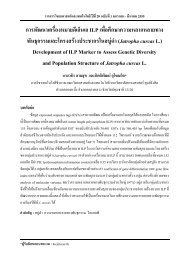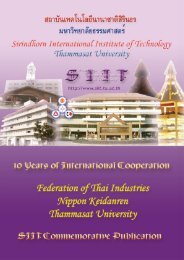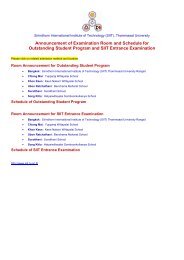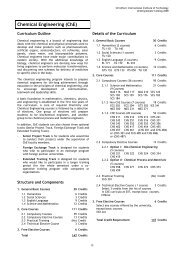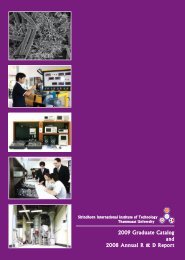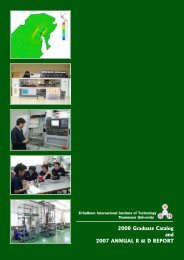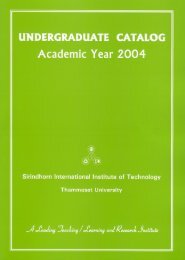2006 Graduate Catalog and 2005 Annual R & D Report - Sirindhorn ...
2006 Graduate Catalog and 2005 Annual R & D Report - Sirindhorn ...
2006 Graduate Catalog and 2005 Annual R & D Report - Sirindhorn ...
Create successful ePaper yourself
Turn your PDF publications into a flip-book with our unique Google optimized e-Paper software.
<strong>2006</strong> <strong>Graduate</strong> <strong>Catalog</strong> <strong>and</strong> <strong>2005</strong> <strong>Annual</strong> R & D <strong>Report</strong><br />
<strong>Sirindhorn</strong> International Institute of Technology (SIIT)<br />
Dr. Stanislav S. Makhanov<br />
Associate Professor<br />
M. Appl. Math., Moscow State University, Faculty of Computational Mathematics <strong>and</strong> Cybernetics, Moscow<br />
Diploma in English Language, Moscow Institute of Foreign Languages, Moscow<br />
Ph.D. in Applied Mathematics, Computer Center of the Russian Academy of Science, Moscow<br />
Areas of Specialization: Image processing, Robotics, Grid generation, Computational fluid dynamics.<br />
Research Interests:<br />
Software for Optimization of the Tool-Path of<br />
Industrial Milling Robots<br />
Innovations in the field of mechanical engineering<br />
have enhanced the involvement of milling robots in<br />
various manufacturing processes. Nowadays,<br />
computer guided milling machines are employed to<br />
produce free-shape surfaces in mass manufacturing<br />
industries such as automobile, airplane, ship-building,<br />
etc. However, several physical phenomena, such as<br />
machine kinematics, thermal effects, static <strong>and</strong><br />
dynamic loading, <strong>and</strong> common-cause failures often<br />
affect the quality of the desired surface. Although<br />
recent research papers have displayed a number of<br />
advanced methods to improve the characteristics of<br />
machining, a robust algorithm to generate the optimal<br />
tool-path for geometrically complex workpieces is still<br />
an open problem.<br />
Image/Signal Reconstruction<br />
Image processing <strong>and</strong> restoration has revolutionized<br />
the fields of medicine, space exploration, geology,<br />
<strong>and</strong> oceanography. A fundamental issue of image<br />
restoration is identification of the distortion in the<br />
presence of observation noise. However, it is well<br />
known that small variations of the initial data could<br />
lead to solutions far from a correct one. Moreover, the<br />
performance of the identification procedures critically<br />
depends on the assumptions regarding the size <strong>and</strong><br />
the shape of the distortion. Therefore, an efficient<br />
procedure should be smart enough to perform an<br />
appropriate regularization <strong>and</strong> to recognize the size<br />
<strong>and</strong> the pattern of the distortion. These features are<br />
particularly important in the case of multi b<strong>and</strong><br />
wavelet based schemes since the procedure can not<br />
be decomposed with regard to filtered components of<br />
the image. The up-to-date Literature on Image<br />
Processing clearly indicates the need for further<br />
research.<br />
Grid Generation Technologies<br />
Grid generation techniques emerged as a subdiscipline<br />
of Computational Fluid Dynamics in the<br />
early seventies. Nowadays grid generators are<br />
among the major components employed by versatile<br />
codes in Geometrical Modeling, Computer Graphics,<br />
CAD/CAM, Structural Analysis, Aerodynamics <strong>and</strong><br />
Computational Fluid Dynamics. However, in spite of<br />
considerable efforts <strong>and</strong> a long time spent on<br />
curvilinear <strong>and</strong> moving grid generation, the theoretical<br />
principles have not been yet established. Grid<br />
generation today is still much more of an art than a<br />
science. Since many different approaches exist <strong>and</strong><br />
are being used, creative craftsmen are needed to<br />
operate the various packages. Therefore, from an<br />
industrial point of view, issues surrounding efficient<br />
implementation, interactive, graphical user interface,<br />
visualization <strong>and</strong> software engineering in grid<br />
generation are of paramount importance.<br />
Dr. Thanaruk Theeramunkong<br />
Associate Professor<br />
B.Eng. in Electrical <strong>and</strong> Electronics Engineering, Tokyo Institute of Technology, Japan.<br />
M.Eng. in Computer Science, Tokyo Institute of Technology, Japan.<br />
D.Eng. in Computer Science, Tokyo Institute of Technology, Japan.<br />
Areas of Specialization: Artificial Intelligence (AI), Natural Language Processing (NLP), Information Retrieval<br />
(IR), Knowledge Data Discovery, Data Mining, Machine Learning (ML), <strong>and</strong> Intelligent Information Systems.<br />
Research Interests:<br />
Natural Language Processing<br />
(1) Robust NLP <strong>and</strong> Linguistic Knowledge<br />
Acquisition<br />
While NLP systems are gradually becoming accepted<br />
by a wider range of people both in academic <strong>and</strong><br />
business area, many difficult problems are still<br />
unsolved. One of the important problems is how to<br />
improve robustness <strong>and</strong> adaptiveness in NLP system,<br />
especially how to analyze <strong>and</strong> interpret various<br />
phrases <strong>and</strong> sentences which are ungrammatical<br />
(also called ill-formed inputs). A user-friendly system<br />
should be robust <strong>and</strong> flexible in that it can analyze<br />
any well-formed <strong>and</strong> ill-formed input efficiently. The<br />
system should also be adaptive to deal with<br />
phrases/sentences including unseen construction <strong>and</strong><br />
vocabulary, for instance learning some new grammar<br />
rules. Currently, we are focusing on both rule-based<br />
<strong>and</strong> corpus-based approaches to cope with ill-formed<br />
inputs <strong>and</strong>, when needed, to acquire novel linguistic<br />
knowledge. On the increase of very large electronic<br />
corpora, statistics obtained from such corpora are a<br />
useful clue for this problem.<br />
26




